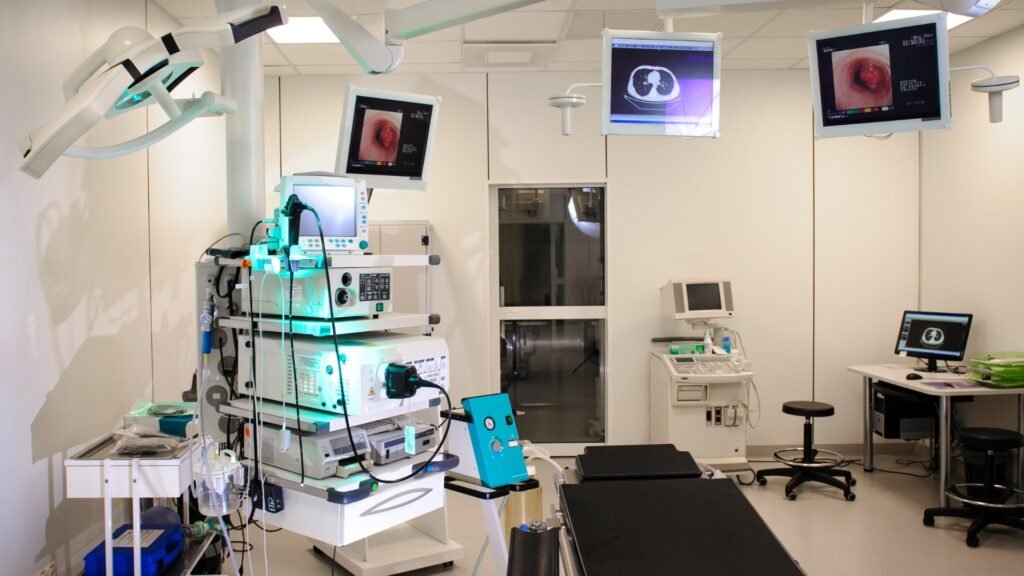Book Appointment Now

The Role of Bronchoscopy in Lung Health: What You Need to Know
Bronchoscopy is a vital procedure in the field of pulmonary medicine, playing a crucial role in diagnosing and treating various lung conditions. By allowing direct visualization of the airways, bronchoscopy provides valuable insights that can significantly impact patient care. This blog aims to educate readers about the importance of bronchoscopy, the procedure itself, and its numerous benefits in maintaining lung health.
What is Bronchoscopy?
Bronchoscopy is a medical procedure that enables doctors to examine the inside of the airways and lungs. It involves the use of a bronchoscope, a flexible or rigid tube equipped with a light and camera, which is inserted through the nose or mouth and guided down the throat into the lungs. There are two main types of bronchoscopes:
- Flexible Bronchoscope: This is the most commonly used type due to its versatility and patient comfort. It allows for easier navigation through the airways and can be used for both diagnostic and therapeutic purposes.
- Rigid Bronchoscope: This type is typically used in more complex cases where greater control and larger instruments are required. It is often used for therapeutic interventions, such as removing large obstructions or controlling significant bleeding.
The choice between a flexible and rigid bronchoscope depends on the specific needs of the patient and the nature of the condition being addressed. Bronchoscopy provides a minimally invasive way to gain critical information about the lungs, making it an invaluable tool in pulmonary medicine.

Indications for Bronchoscopy
Bronchoscopy is employed for a variety of diagnostic and therapeutic purposes, making it a versatile tool in managing lung health. Some common indications include:
- Diagnostic Uses:
- Lung Infections: Identifying the cause of persistent or severe respiratory infections, such as tuberculosis or fungal infections.
- Lung Cancer: Detecting and staging lung cancer by taking biopsies of suspicious areas.
- Inflammatory Diseases: Diagnosing conditions like sarcoidosis or chronic bronchitis by examining and sampling lung tissue.
- Unexplained Symptoms: Investigating unexplained symptoms such as chronic cough, wheezing, or blood in the sputum.
- Therapeutic Uses:
- Removing Obstructions: Clearing blockages caused by mucus, foreign bodies, or tumors to restore normal breathing.
- Delivering Treatments: Administering medications directly into the airways to treat conditions like asthma, chronic obstructive pulmonary disease (COPD), or infections.
- Managing Bleeding: Controlling bleeding in the airways to prevent further complications and ensure patient safety.
These indications highlight the crucial role of bronchoscopy in both diagnosing and treating a wide range of pulmonary conditions, providing a clearer understanding of lung health and facilitating effective medical interventions.
The Bronchoscopy Procedure
Understanding what to expect during a bronchoscopy can help alleviate any anxiety about the procedure. Here’s a step-by-step overview of the process:
- Preparation for the Procedure:
- Pre-Procedure Instructions: Patients may be asked to fast for a few hours before the procedure and to stop certain medications. A thorough medical history and physical examination are conducted to ensure the patient is a suitable candidate for bronchoscopy.
- Sedation and Anesthesia: Patients typically receive a sedative to help them relax and a local anesthetic to numb the throat. In some cases, general anesthesia may be used.
- During the Bronchoscopy:
- Insertion of the Bronchoscope: The bronchoscope is gently inserted through the nose or mouth and guided down the throat into the airways. The doctor uses the camera to visually inspect the airways and lungs.
- Diagnostic and Therapeutic Actions: Depending on the purpose of the bronchoscopy, the doctor may take tissue samples (biopsies), remove blockages, or administer medications directly to the lungs. The procedure usually lasts between 30 to 60 minutes.
- Post-Procedure Care and Recovery:
- Monitoring and Recovery: After the procedure, patients are monitored until the effects of the sedation wear off. It’s normal to experience a sore throat, cough, or mild hoarseness temporarily.
- Post-Procedure Instructions: Patients are given specific instructions on how to care for themselves post-procedure, including when to resume normal activities and any signs of complications to watch for.

Benefits of Bronchoscopy
Bronchoscopy offers numerous benefits that make it an essential tool in modern pulmonary medicine. Some of the key advantages include:
- Minimally Invasive: Unlike traditional surgical methods, bronchoscopy is minimally invasive, which means it involves less pain, lower risk of complications, and shorter recovery times for patients.
- Accurate Diagnosis: By providing direct visualization of the airways and lungs, bronchoscopy allows for precise identification of abnormalities. This accuracy is crucial for diagnosing conditions such as lung cancer, infections, and inflammatory diseases.
- Targeted Treatment: Bronchoscopy enables the direct delivery of medications to affected areas in the lungs, which can be more effective than systemic treatments. Additionally, therapeutic procedures such as removing obstructions or controlling bleeding can be performed during the same session.
- Real-Time Results: The use of a bronchoscope allows doctors to obtain real-time images and conduct immediate biopsies or interventions, facilitating prompt decision-making and treatment.
- Improved Patient Outcomes: By combining accurate diagnosis with targeted treatments, bronchoscopy can significantly improve patient outcomes. Early detection and timely intervention can lead to better management of lung diseases and enhance the overall quality of life.
Risks and Complications
While bronchoscopy is generally safe, it is important to be aware of the potential risks and complications associated with the procedure. These include:
- Bleeding: Minor bleeding can occur at the biopsy site, but it is usually self-limiting. In rare cases, more significant bleeding may require additional intervention.
- Infection: There is a small risk of infection following bronchoscopy. To minimize this risk, sterile techniques are used during the procedure, and antibiotics may be prescribed if necessary.
- Pneumothorax: Although rare, a lung collapse (pneumothorax) can occur if air leaks into the space between the lung and chest wall. This condition may require treatment with a chest tube to re-expand the lung.
- Bronchospasm: Some patients may experience bronchospasm, where the airways constrict and make breathing difficult. Medications can be administered to relieve this condition.
- Adverse Reactions to Sedation: Sedatives used during bronchoscopy can cause side effects such as nausea, vomiting, or allergic reactions. Careful monitoring and adjustments to the sedation protocol help manage these risks.
Understanding these potential risks allows patients to make informed decisions about undergoing bronchoscopy. Healthcare providers take all necessary precautions to ensure the procedure is as safe as possible, and they are prepared to manage any complications that may arise.

Innovations in Bronchoscopy
The field of bronchoscopy has seen significant advancements in recent years, leading to enhanced diagnostic and therapeutic capabilities. Some of the latest innovations include:
- Robotic Bronchoscopy: This cutting-edge technology provides greater precision and control, allowing for the navigation of the smallest airways to reach lesions that were previously inaccessible. Robotic systems enhance the stability and accuracy of biopsies, improving diagnostic outcomes.
- Advanced Imaging Techniques: Innovations such as autofluorescence bronchoscopy and narrow-band imaging offer improved visualization of the airways. These techniques enhance the detection of early-stage cancers and other subtle abnormalities that may be missed with standard imaging.
- Cryobiopsy: This technique involves using extreme cold to obtain larger and more intact tissue samples compared to traditional biopsy methods. Cryobiopsy is particularly useful for diagnosing interstitial lung diseases and other complex conditions.
- Endobronchial Ultrasound (EBUS): EBUS combines ultrasound with bronchoscopy to provide real-time imaging of structures within and adjacent to the airways. This allows for precise needle aspiration of lymph nodes and other masses, aiding in accurate staging and diagnosis of lung cancer.
These innovations are transforming bronchoscopy into an even more powerful tool, enabling earlier detection, better diagnosis, and more effective treatment of lung diseases.
Bronchoscopy is an essential procedure in the field of pulmonary medicine, offering a minimally invasive way to diagnose and treat a wide range of lung conditions. With advancements in technology and techniques, bronchoscopy continues to improve patient outcomes and quality of life. Understanding the role of bronchoscopy in lung health empowers patients to make informed decisions about their care and highlights the importance of seeking timely medical intervention for respiratory issues.
If you or a loved one are experiencing respiratory symptoms or have been advised to undergo a bronchoscopy, schedule a consultation with Dr. Ritesh to discuss your concerns and explore the best diagnostic and treatment options available. Visit our website or contact our clinic to book an appointment and take the first step towards better lung health.


